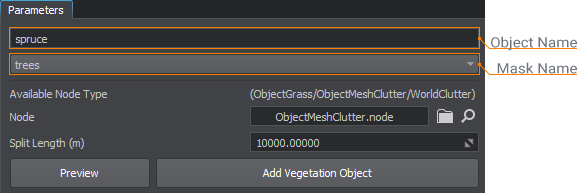植被参数
Vegetation such as trees and grass can be generated via the Sandworm tool based on available landcover data added as a Mask.可以通过Sandworm工具根据添加为Mask的可用土地覆盖数据生成树和草等植被。

An example of creating vegetation is provided here.这里提供了一个创建植被的示例。
Parameters参数#

| Object Name |
The object name displayed in the Objects window and in the World Hierarchy. It can be edited either here (in the Parameters window), or in the Objects window by double-clicking the object you want to rename.在Objects窗口和世界层次结构中显示的对象名称。可以在这里(在Parameters窗口中)编辑它,也可以在Objects窗口中双击要重命名的对象。 |
|---|---|
| Mask |
Mask used to distribute the specified vegetation node across the landscape. The drop-down list contains all added masks.掩码用于在整个景观中分布指定的植被节点。下拉列表中包含所有已添加的掩码。 |
| Node |
Primary object used to generate vegetation: a group of trees or grass.Primary object used to generate vegetation: a group of trees or grass. The following types of primary objects are supported:支持以下类型的主对象:
The process of creating a primary object is described here.这里描述了创建主对象的过程。 注意
Intersections should be enabled for any type of the primary object.十字路口应该支持任何类型的主要对象。 |
| Split length (m) |
Length of the subsegment for splitting mode, in units.用于分裂模式的子段的长度,以单位表示。 Splitting into subsegments is recommended to restrict the size of the generated area (Size X and Size Y of the generated Mesh Clutter) to 10,000 m. Due to the nature of the mesh, there will be visual artifacts connected with the float precision, if a very big Mesh Clutter object is generated (with the side length of around 16,000 m and more). We recommend splitting such big objects to smaller ones. 建议将生成的区域(生成 Mesh Clutter 的 Size X 和 Size Y)到1万米。由于网格的性质,如果生成非常大的 Mesh Clutter 对象,则会出现与浮动精度相关的视觉伪影( 边长约1,6万米及以上)。我们建议将此类大物体分割成较小的物体。 注意
Splitting a segment into too many subsegments (i. e. using very small values) affects the generation time and memory consumption.将一个段分割成太多的子段(即使用非常小的值)会影响生成时间和内存消耗。 |
本页面上的信息适用于 UNIGINE 2.19 SDK.
